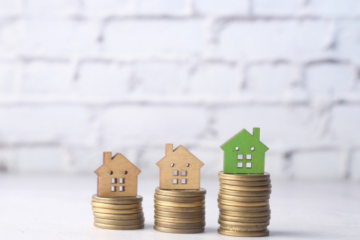Interest rates rise and fall over time. A fixed-rate mortgage protects you from such fluctuations by locking you into a permanent interest rate when you take on the mortgage. The following table shows the main advantages and disadvantages of fixed-rate mortgages.
|
Advantages
|
Disadvantages
|
|
|
|
|
|
|
Fixed-rate mortgages can cover terms of 15, 20, 30, or 40 years. The most common are the 15- and 30-year varieties.
Table of Contents
Balloon Loans
Balloon loans amortize like regular 30-year fixed mortgages, but at the end of a set period of time (usually 5, 7, or 10 years), the total principal balance becomes due all at once. Balloon mortgages typically offer lower rates than their nonballoon equivalents, but the borrower must have the money on hand to pay off the loan in full when it comes due. Balloon loans are best for borrowers who:
- Know for sure that they’ll sell their home within 5, 7, or 10 years (before the balloon payment comes due)
- Are extremely confident that they’ll have the cash required to pay the loan off in full or have a significant boost in their income that will allow them to do so
Negative Amortization Loans
Negative amortization loans have monthly payments that intentionally don’t cover the amount of interest that the borrower should be paying each month. The amount of interest that you don’t pay each month then gets added to the principal. Over time, you can end up owing considerably more on a loan than the property securing the loan is actually worth. Though lenders may try to entice you to buy a home you can’t really afford with a negative amortization loan, you should never take on this type of loan.



4 Comments
How to Decide Between a Fixed-Rate and Adjustable-Rate Mortgage - Realestatejot · December 2, 2021 at 5:42 am
[…] to tell you what your payment will be using various interest rates.) If you’re considering a fixed-rate mortgage, are you comfortable knowing that your payment will remain constant, even if interest rates go […]
How to Choose a Type of Mortgage - Realestatejot · December 2, 2021 at 6:34 am
[…] most important factor in your decision between an ARM or a fixed-rate mortgage is how long you plan to live in the […]
Adjustable-Rate Mortgages (ARMs) - Realestatejot · December 2, 2021 at 6:36 am
[…] monthly payment will increase (if interest rates rise) or decrease (if interest rates fall). Like fixed-rate mortgages, ARMs usually come with 15- or 30-year terms. At the end of the term, you will have paid off the […]
What Is A Mortgage? The Basics For Beginners - Realestatejot · December 2, 2021 at 6:37 am
[…] Fixed-rate mortgages: Mortgages with interest rates that don’t change over time […]
Comments are closed.